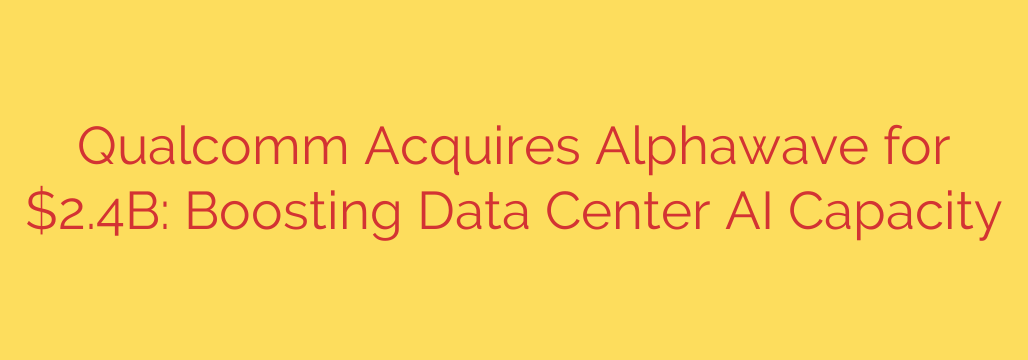
The AI Data Rush: Why Tech Giants Are Acquiring High-Speed Connectivity Companies
The generative AI boom has created an unprecedented demand for computing power. While much of the focus is on the raw processing muscle of GPUs and custom AI accelerators, a critical and often overlooked component is now taking center stage: data connectivity. To win the AI race, it’s not enough to have the fastest chips; you need the fastest way to connect them.
This reality is fueling a new wave of strategic acquisitions in the semiconductor industry. Tech giants are spending billions to acquire companies that specialize in the high-speed “plumbing” of the modern data center. The reason is simple: the most powerful AI processor is useless if it’s starved for data.
The Data Center Bottleneck
Modern AI models, especially large language models (LLMs), require colossal amounts of data to be moved rapidly between processors, memory, and storage, both within a single server and across thousands of servers in a rack. As AI chips get exponentially more powerful, the interconnects—the physical links and protocols that carry this data—have become a major performance bottleneck.
Think of it like a superhighway. You can have the fastest sports cars in the world (the AI chips), but if they are all stuck on a two-lane road (the data interconnect), performance grinds to a halt. To unlock the full potential of their hardware, chipmakers must ensure the data highway is wide enough, fast enough, and smart enough to handle the traffic.
The Strategic Advantage of Acquisition
Building this advanced connectivity technology from scratch is a slow, complex, and expensive process. For major players, acquiring specialized firms offers a much faster and more effective path to market dominance. This strategy is driven by several critical factors:
Accelerated Innovation and Integration: By buying a company that is a leader in data interconnects, a tech giant can immediately integrate that expertise into its product roadmap. This allows for the creation of a vertically integrated platform where the processor, memory, and connectivity are designed to work together seamlessly. This tight integration leads to superior performance, lower latency, and better power efficiency compared to mixing and matching components from different vendors.
Capturing a Larger Share of the Market: The data center is a complex ecosystem. An acquisition expands a company’s portfolio, allowing it to offer customers a more complete solution. Instead of just selling the AI accelerator, they can now sell the entire high-performance package. This strengthens their competitive position and locks customers into their ecosystem.
Owning Critical Intellectual Property (IP): High-speed connectivity is built on decades of research and development. Acquiring a company means acquiring its patents, trade secrets, and, most importantly, its team of experienced engineers. This IP is a powerful defensive moat against competitors and a foundation for future innovation.
The Future is Integrated: Chiplets and Beyond
This trend is about more than just making faster connections. It’s about fundamentally rethinking how data centers are architected. The industry is moving away from monolithic chips toward a more flexible model known as heterogeneous computing, which relies on “chiplets.”
In this model, a large, complex processor is built by combining smaller, specialized chiplets—one for AI processing, one for general compute, one for memory control, and another for high-speed I/O (input/output). For this to work, you need an incredibly fast and efficient way to link these chiplets together. The technology being acquired today is essential for making this vision a reality.
Actionable Tips for IT Leaders
As the industry consolidates around these highly integrated platforms, businesses and IT professionals should take note:
Evaluate the Entire Stack: When making purchasing decisions for AI infrastructure, don’t just look at the performance of a single component. Consider how well the processor, networking, and software are integrated. A vendor that controls the full stack can often deliver superior real-world performance and support.
Monitor Emerging Standards: Keep an eye on new interconnect standards like Compute Express Link (CXL). These open standards will define how components from different manufacturers communicate in next-generation servers. Understanding which vendors are leading in the implementation of these standards can inform your long-term strategy.
Future-Proof Your Infrastructure: The demand for data bandwidth is only going to increase. When planning data center upgrades, prioritize solutions that offer a clear roadmap for scaling connectivity. Choosing a platform with a strong, integrated interconnect strategy is a hedge against future bottlenecks.
In conclusion, the race for AI supremacy is evolving. It’s no longer just about the raw processing power of a single chip but about the seamless, high-speed integration of the entire data center ecosystem. The major acquisitions we are seeing are a clear signal that the companies building the future of AI understand that to win, you have to control not just the engine, but the entire highway.
Source: https://www.datacenters.com/news/qualcomm-s-2-4b-acquisition-of-alphawave-expanding-data-center-capabilities-for-the-ai-era








